Nationwide Engagement Ring Insurance: A Smart Choice
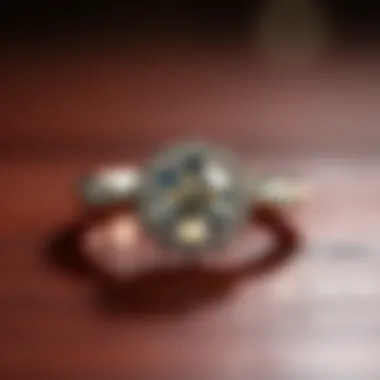
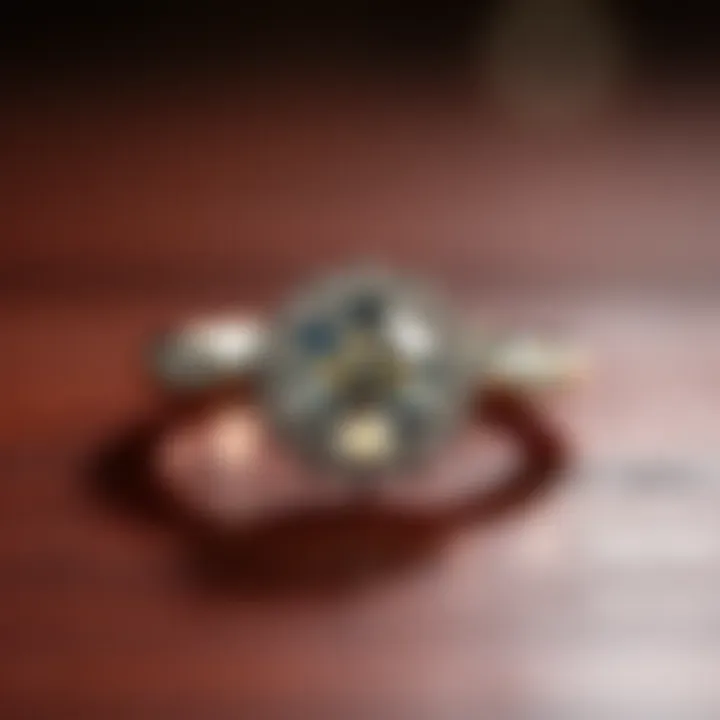
Intro
Engagement rings are not just pieces of jewelry; they embody deep personal significance, honoring love and commitment. Given the emotional value attached, often coupled with a hefty price tag, it’s imperative to consider insurance as a safeguard for this precious investment. The world of engagement ring insurance often appears daunting, filled with terms and conditions, but understanding it can make the difference between peace of mind and potential financial loss. This article explores the ins and outs of nationwide engagement ring insurance, highlighting crucial coverage options, revealing the claims processes, and guiding you through the vital considerations necessary for selecting the best policy tailored to your needs.
Choosing to secure insurance for your engagement ring isn’t merely a proactive approach; it’s an intelligent move that reflects the understanding of the jewelry market and investment principles. Let’s break down the essential elements that contribute to effective engagement ring insurance, ensuring you can navigate this landscape confidently.
Investment Terminology Basics
When discussing engagement ring insurance, familiarizing yourself with some key terminologies can simplify the process. Here are a few critical terms and concepts that will often come up in the context of jewelry and investment.
Key Terms Explained
- Market Value: This refers to the price that the ring would fetch in the current market. This value can fluctuate, influenced by factors such as demand, condition, and design trends.
- Appraisal: An assessment conducted by a qualified gemologist or appraiser to determine the ring’s value. It’s typically required when purchasing insurance to establish a baseline for coverage.
- Premium: This is the amount you pay for your insurance policy, often presented annually or monthly. The premium can vary based on factors like the ring’s value and your coverage level.
- Deductible: The amount you must pay out of pocket before the insurance kicks in, usually agreed upon when setting up the policy.
Common Investment Strategies
While engagement rings are a less conventional investment compared to stocks or real estate, they can still appreciate in value. Here are a few strategies that may apply:
- Long-Term Holding: This involves keeping the ring over many years, allowing its value to potentially increase as market demand rises.
- Value Enhancement: Maintaining and sometimes upgrading the ring can help preserve or even enhance its current market value. This could mean regular cleanings or having it appraised periodically.
- Diversification: Just like any investment portfolio, diversifying your asset types can be beneficial. Pairing your engagement ring with other forms of insurance or assets can help safeguard against potential losses in a single area.
"Investing in proper insurance for your engagement ring is akin to wearing a seatbelt in a car—essential for safeguarding what matters most."
Understanding these terms gives you a strong foundational knowledge as you delve deeper into the specifics of securing insurance for your engagement ring. With this understanding, you can now turn your attention to the available coverage options and how best to protect your significant investment.
Understanding Engagement Rings
Engagement rings are not just pieces of adornment; they symbolize commitment, love, and a shared future. The importance of comprehending engagement rings extends beyond their mere aesthetic value. This article explores various aspects, such as their historical significance and contemporary trends, both of which highlight their evolving role in people's lives and relationships.
When individuals are considering an investment in an engagement ring, they should take into account the relationship they are nurturing. This rings true especially with the financial implications involved in purchasing such jewelry. Understanding the different types and qualities of rings can guide potential buyers in making a choice that resonates with their personality, lifestyle, and budget.
Historical Significance of Engagement Rings
The tradition of giving engagement rings dates back centuries. In ancient Rome, brides were given a band made of iron, signifying strength and permanence. As societies evolved, so did the materials of these rings. Diamonds, in particular, gained immense popularity thanks to a well-marketed campaign in the 20th century that declared, "A diamond is forever." This phrase has cemented the idea that engagement rings are not only a promise of love but also a legacy of family and tradition.
By diving into history, one can appreciate how engagement rings have been a reflection of changing societal values, class distinctions, and even economic conditions. Understanding this history can enhance the sentiment behind the decision to purchase and insure an engagement ring.
Modern Trends in Engagement Rings
Today, the landscape of engagement rings is as diverse as the individuals who wear them. Couples are moving away from the conventional diamond solitaire, exploring options like colored gemstones or vintage-inspired designs. The rise of ethical considerations has led many to opt for lab-grown diamonds, ensuring they make choices aligned not only with personal values but also with broader social impacts.
Furthermore, customization has become a significant trend, allowing couples to express their unique love stories. From intricate engravings to bespoke designs, modern engagement rings are becoming canvases of personal expression rather than just standard pieces of jewelry.
Investing time in understanding current trends can immensely benefit couples as they select engagement rings that speak to their identities and values. It also posits a practical consideration when thinking about insurance, as trends can directly influence the value of a piece.
"Understanding the significance of engagement rings can lead to wiser investment choices, ensuring both value and sentiment are safeguarded for years to come."
The Importance of Insurance for Engagement Rings
When it comes to engagement rings, the emotional and financial stakes are high. These rings often symbolize deep affection and commitment, making their protection paramount. Engaging in the pursuit of an engagement ring policy is not merely about the financial aspect; it’s about safeguarding memories and futures.
Financial Protection Against Loss or Theft
The world is unpredictable; one moment a glittering engagement ring sparkles on your partner’s finger, and the next, it might vanish. Engagement rings, particularly those featuring valuable gemstones like diamonds or sapphires, can represent a significant financial investment, often exceeding thousands of dollars.
Insurance offers a safety net against unexpected losses or theft. Imagine losing your beloved ring on a vacation or having it stolen from your home. Without insurance, the financial burden could be overwhelming. Coverage can often recoup the full value of the lost item, thus easing the burden on your finances and allowing you to replace the ring without a financial hiccup. This aspect emphasizes how vital it is not to overlook insurance while celebrating love’s long-lasting bond.
Protection from Damage
Rings are not just accessories; they are heirlooms. Over time, daily wear can take a toll. Accidental scratches, chips, or even more serious damages can alter they way a ring glimmers. With insurance, the matter of repairs or replacements can also be covered.
Policies might provide coverage for various incidents, like
- Accidental damage: This includes everything from being clipped by a door to setting your mug down too hard.
- Repair or restoration: If the settings come loose or a stone becomes unset, insurance can cover repair costs, ensuring that the ring’s charm remains intact.
In this regard, insurance acts as a guardian, preserving the ring’s physical integrity and the emotional weight it carries.
Preservation of Sentimental Value
An engagement ring holds a unique place in people’s hearts; it’s often tied to personal stories, shared dreams, and significant moments. The emotional investment in a ring is far greater than its monetary value. Insurance not only protects the monetary investment but also preserves the memories wrapped around that ring.
If a ring is lost or damaged, feelings of disappointment can wash over a person. By securing an insurance policy, one ensures that the ability to recreate or restore that symbol of love and commitment is always available. Regardless of the situation, having that peace of mind can foster emotional stability.
"Securing an engagement ring with insurance is a proactive step in ensuring that love's symbol remains untarnished, both physically and emotionally."
In sum, understanding the importance of engagement ring insurance brings to light three areas: safeguarding a financial investment, protecting physical property, and preserving sentimental value. A well-rounded policy serves as a comprehensive shield, enabling couples to focus more on their profound bond without the lurking worry of unforeseen misfortune.
Types of Engagement Ring Insurance Policies
When investing in an engagement ring, understanding the types of insurance policies available becomes crucial. With various options tailored to meet both individual needs and lifestyles, knowing the right fit could save not just money but also a lot of heartache in case of misfortune. In this section, we will explore two main categories of insurance policies—jewelry-specific and homeowners or renters insurance add-ons—examining their benefits and considerations for the discerning buyer.
Jewelry-Specific Insurance Policies
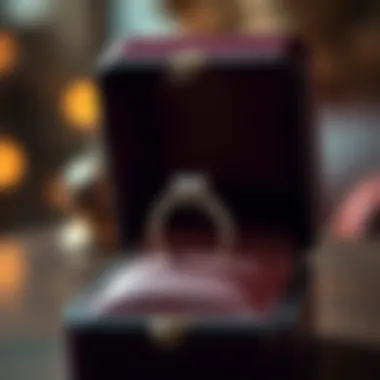
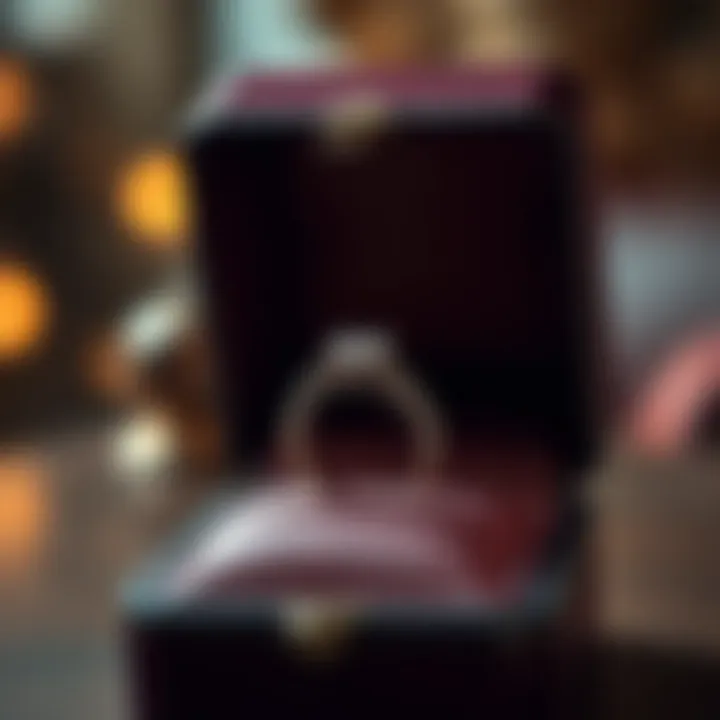
Jewelry-specific insurance policies stand apart by offering dedicated coverage to precious items like engagement rings. Unlike general policies, these plans focus exclusively on your jewelry’s unique needs. Here are some of the key advantages:
- Comprehensive Coverage: These policies often cover loss, theft, damage, and even mysterious disappearance, which can sometimes be a nail-biter. Standard homeowners policies may fall short when it comes to jewelry.
- Replacement Cost: Should disaster strike, such policies typically present a replacement value that mirrors the ring’s worth, rather than depreciated value often seen in standard covered items.
- Easier Claims Process: Singular focus can streamline handling claims compared to going through a broader insurance provider where jewelry may not be their main priority.
Many buyers appreciate the peace of mind that jewelry-specific insurance can offer. These policies emphasize protection tailored for your exquisite piece, ensuring it stays secure through life’s unpredictabilities.
Homeowners or Renters Insurance Add-Ons
On the other hand, choosing to add engagement rings to your homeowners or renters insurance might be a more economical path for some. This option generally comes with a few advantages:
- Affordability: Many find it more cost-effective, as adding jewelry can often come at a lower premium than standalone policies.
- Bundled Coverage: If you are already paying for homeowners or renters insurance, incorporating your engagement ring means fewer policies to manage, keeping things neat and tidy.
- Basic Protection: Homeowners and renters insurance often include some level of coverage against various risks, which can prove helpful if the ring is lost in a household incident.
However, buyers must keep a few considerations in mind. Often, these policies may not cover the full value unless specified, which could leave gaps—especially in cases of theft or loss outside the home. Regular appraisals or documentation are essential to ensure that coverage amounts reflect the current value of your ring.
For those contemplating jewelry insurance, it’s essential to weigh these options carefully. Depending on your lifestyle, budget, and sentiments attached to the piece, the right choice is out there, waiting to keep your investment safe—or at least, as safe as it can be in this unpredictable world.
"Insurance is the foundation of protection for valuable assets – make sure yours is solid!"
Assessing the Value of Your Engagement Ring
Determining the value of your engagement ring is a crucial step in the journey of securing insurance coverage. This process not only helps you understand the financial worth of your investment but also plays a key role in tailoring your insurance policy to suit your specific needs. When you assess the value of your ring, you’re gaining insights that can guide both its protection and your future financial planning.
Professional Appraisal Process
A professional appraisal is like viewing your ring through a lens of expertise. This process entails taking your ring to a certified appraiser, who evaluates it based on several technical factors, such as size, clarity, cut, and carat weight of the gemstone, along with the metal type used in the band. Appraisers might also consider market demand and trends that can influence value. In this detailed examination, they produce a valuation report that spells out the ring's worth, often accompanied by a certification of the diamond or gemstones.
You might wonder why you should bother with a professional appraisal rather than estimating the value on your own. Well, while the internet provides retail prices for similar pieces, it doesn’t account for nuances such as brand reputation or the unique craftsmanship of your ring. A thorough appraisal can provide you with a precise valuation and also gives you a leg to stand on when you’re shopping for insurance. Having this report handy, you can ensure that your coverage reflects the true value of your jewelry asset, not just a guesstimate.
Factors Influencing Ring Value
Engagement ring value isn't etched in stone—several factors play a part in determining how much your ring is worth:
- Quality of Gemstone: The 4Cs of diamonds—cut, color, clarity, and carat—are fundamental in assessing the value. A brilliant, well-cut diamond, for instance, carries more weight than one that is poorly cut.
- Metal Type: The choice of metal significantly affects value. Platinum and gold are popular choices, with platinum generally valued higher because it's denser and more durable.
- Age and Origin: Vintage rings might carry historical significance or more intricate craftsmanship, which can enhance their value. If your ring comes from a renowned jeweler, that also adds a layer of prestige.
- Market Trends: Jewelry trends shift like quicksand; what’s hot today may not be tomorrow. Keeping an eye on current market trends could help you appraise or even sell the ring later.
- Condition: A well-maintained ring retains more of its value over time. Any damage—such as a worn-down prong or scratches on the band—can diminish its worth.
The knowledge of these influences not only helps you understand how to appreciate your engagement ring over time, but also lays the groundwork for securing adequate insurance coverage. Armed with this information, you can approach potential insurers with confidence, ensuring you’re fully covered in case of any unforeseen events.
Key Features to Consider in an Insurance Policy
When it comes to insuring that sparkly engagement ring, you're not just throwing money at a protection plan. It's crucial to consider the specific features of the policy you choose. Investing time and thought into this process can save you headaches down the road. Let’s break down some of the key features of an insurance policy that can make a world of difference in your peace of mind.
Coverage Limits
One of the first things to check is the coverage limit of your policy. This is essentially the maximum amount the insurer is willing to pay for loss or damage to your ring. You want to make sure that the coverage limit matches or exceeds the actual appraised value of your ring.
- Why does this matter? Well, if your beloved ring is appraised at $10,000 but your policy only covers $5,000, you could be left in a real bind if ever something happens to it. In the worst case scenario, you lose the ring and then you're staring down the barrel of losing a significant chunk of change.
- Some policies may also have different limits depending on the type of incident, like theft versus loss. This nuance can become vital when it really counts.
Deductibles and Premium Costs
Continuing along this path, let's talk about deductibles and premiums. The deductible is the amount you will need to pay out-of-pocket before the insurance kicks in. A higher deductible usually means a lower premium, and vice versa. But it’s essential to strike a balance between the two.
- When deciding on the deductible, ask yourself how much you can realistically afford to pay in case of a claim. If a policy has a deductible of $1,000 but a premium of only $30 a year, is it worth it? If you lose your ring, you might find yourself wrestling with that hefty deductible, and that’s not something you want to deal with while already feeling down about your loss.
- Additionally, note how premium costs can change over time. Keep an eye on annual renewal notices; increases in premium can happen based on various factors, including the insurer’s overall risk assessment and claims history.
Claims Process and Customer Support
Lastly, a smooth claims process and solid customer support is what you want as a safety net. You want to feel confident that if, or when, something does happen to your engagement ring, the insurance process is straightforward and uncomplicated.
- Before signing on the dotted line, take a good look at insurance reviews related to claims handling. Some companies might promise the moon, but when you dig deeper, you might find that their customer service leaves much to be desired.
- Furthermore, a complex claims process can feel like pulling teeth when you're already stressed about a loss. Ease of claims filing—either online, through an app, or via phone—may save you time and frustration when you find yourself in that unfortunate position. Don’t hesitate to ask questions about the claims process before committing.
"Insurance is a safety net, not just a policy. Choose wisely."
In summary, focusing on these key features of your insurance policy can mean the difference between mere coverage and true peace of mind. Proper evaluations of coverage limits, deductibles, and the overall claims process help in ensuring that you choose a plan that fits not only your budget but also your needs.
How to Choose the Right Insurance Provider
When it comes to safeguarding an engagement ring, selecting the right insurance provider is just as crucial as the choice of the ring itself. Without a solid insurance policy, a precious investment may dwindle into an irreplaceable loss. Understanding how to navigate the landscape of insurance providers can help ensure that you make an informed decision that fits your needs perfectly. This process isn't simply about finding the cheapest option; rather, it's about aligning with a provider that resonates with your specific concerns and values.
Researching Insurance Providers
In the sea of insurance companies, each promising gold at the end of the rainbow, you ought to embark on a deep dive. Begin with a sprinkle of online research coupled with a dash of local insight.
- Reputation Matters: Look for insurance companies that have built a solid reputation. You can start with reviews on websites such as Trustpilot or Consumer Affairs. Ratings and customer feedback can reveal much about an insurer's reliability. A provider with a long-standing reputation often reflects stability and trustworthiness.
- Verify Credentials: Only consider companies licensed to operate in your state or country. The state insurance department's website often lists licensed providers. This gives you peace of mind that the insurer abides by regulations and standards.
- Specialization: Not every insurer specializes in jewelry coverage. Investigate if the provider has specific policies for engagement rings or fine jewelry. Companies like Jewelers Mutual focus primarily on jewelry insurance and often tailor their policies accordingly.
Engaging in a bit of homework may seem tedious, but the payoff can be significant. You want to align yourself with an insurer that understands the emotional and monetary value you place on your ring. Because let’s face it—few things sour a celebratory moment like finding out that your chance of recovery is as slim as a pencil's eraser.
Reviewing Customer Testimonials and Ratings
Customer experiences often shape the public perception of an insurance provider. While surfing through testimonials, you can gauge the real-world application of their services. Here are a few key points to consider:
- Real Stories: Seek out reviews that share real claims experiences. What did customers say about their claims process? Did they find the insurer easy to communicate with during stressful moments?
- Response Time: Consider how promptly a provider handles claims. A company that's slow to respond could lead to frustration at crucial times.
- Claims Denials: Every insurance provider has some denials, but too many can signal a red flag. Look into the reasons customers have faced denials. Understanding policy exclusions can help you avoid unpleasant surprises in the future.
Remember, the sneaky complexities of policy language can be a labyrinth. Glean as much truth as you can from the community and prior clients and you’ll naturally become more equipped to navigate the insurance world.
"An ounce of prevention is worth a pound of cure.” - Benjamin Franklin
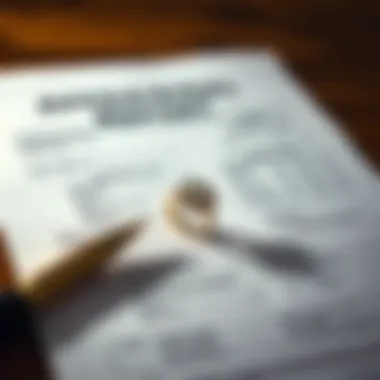
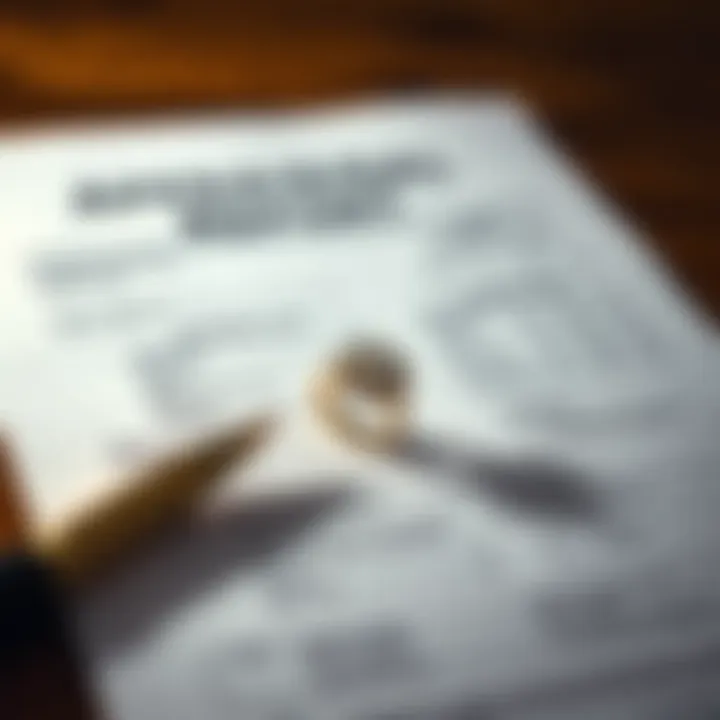
The Process of Making a Claim
Understanding how to file a claim on your engagement ring insurance is as crucial as acquiring the right policy in the first place. Even with a robust insurance plan, knowing the proper process ensures that you can recuperate your losses in times of despair. It's not just about money; it's about the emotional weight attached to your jewelry. A quick and efficient claims process can mean the difference between a stressful ordeal and a seamless transition back to normalcy.
Steps Involved in Filing a Claim
When you find yourself needing to file a claim, having a roadmap can greatly simplify the process. Here’s a step-by-step guide:
- Review Your Insurance Policy: Before taking any action, dive into your policy documents. Know the coverage details, limitations, and exclusions. This initial step saves time later on. Missing details can lead to frustrations.
- Document the Incident: Whether it's a loss, theft, or damage, gather all necessary information. Take photos, write down timelines, and keep receipts or appraisals handy. Good records give you a stronger standing when you file.
- Contact Your Insurer: Reach out to your insurance agent either over the phone or via the company’s online portal. Be ready with your policy number and details about the incident. Some companies provide dedicated claims representatives to ease navigation through the claims process.
- Fill Out the Claim Form: You’ll need to complete a claims form, which typically requires providing personal details, specifics about the item, and a description of the loss or damage. Take your time to fill this form out accurately.
- Submit Supporting Documents: Attach all collected documents. This could include the gemstone certificate, photographs of the ring, police reports (in case of theft), or any other relevant evidence. Strong supporting documents will back up your claim.
- Await the Adjuster’s Review: The insurance company may assign an adjuster to evaluate your claim. They’ll review the provided documents and potentially inspect any damaged items. This is where having a good account of everything comes in.
- Receive a Decision: After the evaluation, you’ll receive a decision from your insurer. If approved, they will provide compensation amount.
- Follow Up if Necessary: Don’t hesitate to follow up on your claim if you feel it’s taking too long. Polite persistence often yields fast results.
Common Challenges and How to Avoid Them
While the claims process can be relatively straightforward, there are several common hurdles that individuals encounter. Being mindful of these can help you avoid potential pitfalls:
- Lack of Documentation: Neglecting to keep records can stall your claim. Keep all appraisals, receipts, and any correspondence labeled and accessible. Consider creating a digital copy for easy access.
- Not Knowing the Policy Limits: Each insurance policy comes with its own limit on coverage. Understanding this is vital, particularly during filing. Knowing how much you can claim can shape your expectations.
- Delayed Reporting: Many policies have a timeframe within which claims must be reported. Failing to report in time can lead to denial of the claim. If something happens, don’t delay in notifying your insurer.
- Miscommunication: Be clear and honest when communicating with your insurer. If there are discrepancies in information provided, it can lead to complications later on.
- Ignoring Follow-Up: Once you file a claim, don’t just sit back. Stay engaged and check in regularly. Sometimes claims can get lost in the shuffle without proactive follow-up.
When it comes to protecting your investment, being proactive in understanding the claims process can take a weight off your shoulders. A well-informed policyholder stands a better chance of having their claims fulfilled promptly and effectively. Remember, the journey doesn’t have to feel like a maze; clarity and organization can light the way.
Best Practices for Maintaining Your Engagement Ring
Engagement rings are not just symbols of love; they also represent significant financial investments. Thus, maintaining their condition is essential for both aesthetic appeal and insurance valuations. Regular upkeep can help preserve their beauty and integrity, ensuring they remain cherished pieces for years to come.
Regular Inspections and Cleaning
Engagement rings are often worn daily, exposed to the wear and tear of life. Regular inspections should be part of your routine to catch any possible issues before they escalate. Look for signs of damage, such as loose stones or worn prongs. Ideally, you should inspect the ring at least once a month. This practice allows you to identify any wear and tear early, preventing the potential loss of a valuable gemstone.
When it comes to cleaning, there are at-home and professional options. At-home cleaning can be done using a mild soap and water solution along with a soft-bristled brush. This method will remove dirt and oils that can accumulate over time. For a more thorough cleaning, consider taking the ring to a jeweler every six months. Jewelers often use ultrasonic cleaners that can reach every nook and cranny, making your ring sparkle anew.
"An ounce of prevention is worth a pound of cure."
Safe Storage Solutions
When not wearing your engagement ring, proper storage is key to maintaining its condition. Avoid storing it in places where it might get scratched or knocked against other jewelry. Instead, keep it in a soft-lined jewelry box or a designated pouch. Some people opt for individual compartments to separate rings, minimizing the risk of damage.
Additionally, consider humidity and temperature when storing your ring. Extreme conditions can adversely affect gems and metals. A climate-controlled environment, away from direct sunlight, is ideal.
Organizing your jewelry in a cool and dry space can prolong its life and keep it looking fabulous. The peace of mind that comes from knowing your investment is protected is invaluable, making these storage solutions worth considering.
The Role of Gemstone Certificates
Gemstone certificates hold a significant role in the context of engagement ring insurance. They are not merely pieces of paper; they serve as an official acknowledgment of the quality, origin, and authenticity of the gemstones in your ring. When you own an engagement ring worth a small fortune, having a robust certificate can make the difference between a smooth insurance process and a headache down the line.
Importance of Certification in Insurance
The importance of certification stretches far beyond verifying the characteristics of your gemstone. Certificates provide assurance to both the insurance companies and the ring owner. Here’s why:
- Proves Authenticity: Many insurance providers require certification to confirm that the gemstone in question is, indeed, what you claim it to be. A legitimate certificate from a recognized gemological laboratory can help prevent fraudulent claims.
- Determines Value: The appraisal value often closely hinges on the details provided in the gemstone certificate. This includes attributes such as carat weight, clarity, cut, and color. A well-documented certificate will support your valuation in the event of a claim—saving you from unwelcome surprises.
- Enhances Trust: Insurers are more likely to give coverage to rings backed by certified gems compared to those without documentation. Certification fosters a sense of trust and legitimacy in your ownership.
In short, when insuring your engagement ring, certification is not simply an added advantage—it is a necessity. A certificate validates the worth of your investment and provides peace of mind that you are properly insured.
Where to Obtain Gemstone Certification
Obtaining a gemstone certificate is not as intimidating as it may seem. Here are the primary steps you can follow to secure that all-important document:
- Select a Reputable Lab: Look for gemological institutions renowned for their credibility. Examples include the Gemological Institute of America (GIA) and the American Gem Society (AGS). These organizations have rigorous standards and are recognized in the industry.
- Submit Your Gemstone: You’ll need to send your gemstone to the lab for analysis. This step requires some precautions, as you don’t want to lose your precious item in transit. Use a reputable shipping service and secure insurance for this step.
- Await Analysis: After submission, the laboratory will analyze the gemstone using advanced equipment and gemological techniques. The process may take a couple of days to weeks depending on the lab's workload.
- Receive Your Certificate: Once the analysis is complete, you’ll receive a detailed report that documents the specifications of your gemstone. The certificate typically includes information about clarity, cut, carat weight, and color along with a unique identification number.
Comparing Insurance Options: A Practical Approach
When it comes to engagement ring insurance, evaluating your options isn’t just a good idea – it's essential. With various policies out there, understanding the nuances can significantly affect long-term benefits. Investing time into comparing your options will ensure you find a policy that matches your needs while safeguarding your cherished asset.
Let’s break down this process into manageable parts. It’s not merely about comparing prices; it's also about assessing coverage and value for money. When you look beyond the surface, you will see that the most suitable insurance policy not only protects your investment but also brings peace of mind.
Creating a Decision Matrix
A decision matrix can serve as a robust tool in highlighting the differences between various insurance options. Think of it like playing cards; you lay everything out to see what your hand looks like. By creating rows and columns to include different policies and their key features, you can visualize critical elements at a glance.
Here’s how to set it up:
- List Insurance Providers: On one axis, jot down the names of the insurers you're considering.
- Key Features: On the other axis, include essential coverage aspects like premiums, coverage limits, deductibles, and exclusions.
- Rating System: Create a simple rating system from 1 to 5 for each policy based on your research and needs.
This straightforward approach will clarify which policies offer comprehensive coverage and value, allowing for an informed choice. Visibility in decision-making is key, especially for decisions involving significant investments.
Working with Insurance Agents
Having a knowledgeable insurance agent can make navigating the waters of engagement ring insurance much smoother. These professionals bring expertise into the fray, often highlighting the nuances that aren’t glaringly apparent. When engaging with agents, don’t hesitate to ask pointed questions:
- What is the Claims Process? Understanding how a claim is filed can save you a headache later.
- Are There Waiting Periods? Knowing if you have to wait for coverage to kick in can be crucial.
- How do Policy Changes Affect Coverage? This insight helps in understanding future adjustments and maintaining adequate protection.
Take notes during these discussions. An agent is not just your advisor; he or she is also a partner in protecting your asset. Their experience can aid in deciphering the fine print. A good agent will not shy away from putting things into simpler terms and ensuring you know what you’re getting.
Understanding Policy Exclusions and Limitations


When delving into the realm of engagement ring insurance, comprehending exclusions and limitations within your policy is paramount. While insurance promises protection, it's crucial to grasp what it does not cover. Understanding these boundaries ensures you are not caught off guard in times of need. Violations of policy coverage can turn a sense of security into a heartbreaking misfortune, so being aware of these terms can truly mean the difference between peace of mind and financial reckoning.
By examining exclusions, you’ll understand risks that remain unprotected, enabling you to mitigate loss and even negotiate better terms with your insurance provider. For instance, you might discover that wear and tear from everyday use isn’t covered, which could prompt you to take proactive measures.
Moreover, addressing limitations on coverage can reveal the maximum amounts the insurance company will reimburse in the event of a claim. Policies can sometimes offer peace of mind on the surface, but if the fine print reveals inadequate coverage for valuable items, the investment made into insurance may fall short.
Common Exclusions in Policies
Every insurer has its own set of common exclusions, and these can greatly influence the effectiveness of your coverage.
- Wear and Tear: Many policies explicitly state that they do not cover damage occurring over time due to regular use. This means that while your ring might be beautiful, wearing it daily may slowly degrade its condition without insurance support.
- Loss in Value: If your engagement ring’s value diminishes for any reason—market conditions or jewelry trends—most policies generally won’t reimburse the difference.
- Unapproved Repairs: If a ring is repaired or altered by a jeweler not authorized by the insurance company, claims related to that ring may be denied.
- Intentional Acts: If damage occurs due to negligence or intentional acts, the insurance policy typically won’t honor claims under such circumstances.
- Specific Risk Exclusions: Events like earthquakes, floods, or wars could be noted in exclusions; thus, if your ring is lost in such an instance, you could be left high and dry.
Being conscious of these exclusions isn’t just a matter of knowing what could happen; it’s about strategically protecting your investment.
Limitations in Coverage Amounts
Limits come into play as well regarding how much can be recovered through your policy. It’s vital to think critically about it.
- Maximum Payouts: Many insurance policies specify caps on what they’ll reimburse for contents like engagement rings. If a ring is valued at $10,000, but your policy has a payout limit of $5,000, you’re potentially at risk of losing a substantial amount.
- Daily Value Adjustments: Some providers may adjust coverage based on an annual assessment. If your ring appreciates but your coverage doesn’t reflect this increase, you might find yourself at a disadvantage during claims processing.
- Factors Determining Payout: Policies often have differing limitations on costs associated with specific loss types; theft may have a different limit than damage during various situations. Understanding these differences can help gauge how gaps in coverage might affect your finances.
In summary, while insuring your engagement ring is a wise decision, understanding the exclusions and limitations within your policy is equally crucial. This knowledge equips you to make informed decisions and ensure your significant investment is truly safeguarded.
The Long-Term Value of Engagement Ring Insurance
Engagement ring insurance often emerges as an afterthought during the joy of planning a wedding. Yet, recognizing its long-term value is tantamount to safeguarding a treasured investment. The average price tag of an engagement ring can make one’s heart skip a beat, and that’s before you even think about the emotional value tied to it. Investing in engagement ring insurance not only provides peace of mind but also ensures that your cherished piece remains protected against the unpredictable twists of life.
Investing in Peace of Mind
When you hear the phrase "peace of mind," it might sound like just another buzzword, but for many, it embodies a crucial element of their engagement experience. Knowing your engagement ring is insured alleviates fears of loss, theft, or damage. Consider this: you’re out on a romantic dinner, and suddenly you realize your ring is missing. Panic sets in, right? But if you’ve got coverage, there's a safety net waiting for you.
- Coverage options vary. Depending on the policy you choose, features can range from complete replacement to cash value compensation, tailored to keep your financial future secure.
- Peace in daily life. Imagine wearing your jewel without the nagging anxiety of potential mishaps—this is where insurance shines the most. It allows you to enjoy your ring as intended, making it a part of your daily life rather than a fragile item you have to protect with kid gloves.
Buying an engagement ring is about commitment— insurance plays a pivotal role in that commitment, extending it into the material realm. Protecting a meaningful item doesn’t just make financial sense; it speaks volumes to the significance placed upon that personal relationship.
Adapting Coverage as Value Changes
The value of an engagement ring can fluctuate over time, making it crucial to reassess your insurance policy regularly. Market trends, which can influence the value of precious metals and stones, mean that adapting coverage is not only smart—it's necessary.
- Initial Purchase vs. Current Value: Initially, you might have paid a certain amount, but as years pass, you should ensure that your policy reflects current market values. What seemed like a good deal could now be undervalued.
- Periodic Appraisals: Engaging in regular appraisals can provide insights into how much your ring appreciates in value. Keeping an up-to-date appraisal document handy can streamline this process when it’s time to adjust coverage.
- Insurance Inflation Protection: Some policies offer inflation protection options to prevent you from falling behind as the market changes. This means when you need your ring replaced, the coverage you're receiving is as substantial as the investment you made.
"Regularly updating your coverage isn’t just wise; it’s taking proactive steps to ensure that your investment holds its value long-term."
Without regular updates to insurance coverage, you risk facing substantial out-of-pocket expenses should the unexpected happen. It's essential to navigate changes in value with diligence, ensuring that you won’t find yourself caught short if the worst occurs. By focusing on these aspects, you ensure your engagement ring remains a treasured symbol of your commitment for years to come.
Future Trends in Jewelry Insurance
As the landscape of jewelry insurance evolves, it becomes increasingly vital for individuals to stay updated on the future trends impacting their coverage. Fluctuating consumer demands and advancements in technology are reshaping the way we think about protecting our prized possessions, especially engagement rings—a significant financial and emotional investment.
Emerging Technologies in Insurance
In recent years, the integration of technology in insurance policies has opened a new frontier. From smart glasses that offer augmented reality assessments of jewelry to mobile apps that monitor jewelry conditions, convenience is at the forefront. One noteworthy advancement is the application of blockchain technology. This ensures a secure and transparent method of tracking ownership and authenticity of jewels.
For instance, a person could upload the details of an engagement ring to a blockchain, where all transactions and certifications are permanently recorded. This could be invaluable in proving ownership during a claim process, helping insurers to mitigate risks, and potentially speeding up the payout process.
Moreover, many insurers are now offering policies through online platforms, making it easier to compare and acquire coverage without stepping foot into an office. This not only streamlines the purchasing experience but also makes finding competitive rates more achievable.
Changing Consumer Preferences
As the world becomes more connected, consumer preferences regarding engagement ring insurance are changing dramatically. There's a growing awareness of the importance of comprehensive coverage beyond the typical policies offered in the past. As people increasingly lean towards customization and personalization in their jewelry choices, they also seek insurance policies that reflect these individual needs
The demand for flexible policies is also on the rise, allowing for updates to coverage as the value of jewelry fluctuates. Consumers now want the ability to adjust their policies quickly without excessive fees or complications. Many prefer user-friendly platforms that provide real-time updates on their insurance status, showcasing a shift towards a more engaged and informed customer.
Additionally, sustainability and ethical considerations are becoming focal points. Modern buyers care about where their diamonds and metals come from, and they want to ensure their insurance provider reflects those values. Policies that offer coverage on ethically sourced and environmentally friendly jewelry are gaining traction, appealing to the conscientious consumer.
"In today’s fast-paced world, being in tune with customer expectations and technological advancements is not just beneficial, it’s essential for the jewelry insurance industry to thrive."
By recognizing these emerging trends, both consumers and insurers can navigate the landscape of engagement ring insurance with a sharper, more informed approach, ensuring their investments are safeguarded against the uncertainties of life.
Epilogue: The Necessity of Engagement Ring Insurance
In the intricate world of jewelry, particularly engagement rings, insurance serves as a crucial safeguard for individuals who own these splendid symbols of commitment. As the saying goes, Better safe than sorry, and this holds particularly true when it comes to such substantial investments. An engagement ring isn't just a piece of jewelry; it embodies love, memories, and a future shared. Therefore, protecting that investment through proper insurance is not merely wise but essential.
First off, consider the sheer financial value these rings can represent. With many spending thousands—sometimes tens of thousands—of dollars, proper insurance copes with the alarming realities of theft, loss, or damage. It's not just about the monetary aspect; it's also about the emotional bond tied to these mementos. Losing a ring can feel like losing a piece of your relationship itself.
As you weigh the necessity of engagement ring insurance, keep in mind the different coverage options available. Jewelry-specific policies, distinct from homeowners' or renters' insurance add-ons, often provide tailored coverage that can better suit the nuances of your precious piece. This specificity ensures not only that you're covered for loss but also for potential damages that arise through everyday wear and tear. Some people might dismiss insurance as an unnecessary expense, but like any preventive measure in life, it's more about peace of mind and practical security.
Additionally, considerations surrounding the policy terms and conditions can be daunting but are vital. When engaging with insurance providers, it is essential to scrutinize the exclusions and limitations embedded in the contractual language. For instance, an unwitting buyer may find themselves covered only in specific circumstances, leaving them vulnerable to unaccounted situations. Knowledge and comprehensive understanding here empower consumers, ensuring they get the coverage they need without unwelcome surprises in the case of a claim.
To make the most of engagement ring insurance, the best practice should involve not only purchasing but also periodically reassessing your policy. As the personal value of the ring evolves—whether through market changes or sentimental growth—updating the appraisal of its worth remains paramount. This ensures that coverage is not lagging behind the current value, thus safeguarding against underinsurance.
In summary, investing in engagement ring insurance is about more than just numbers; it’s about the preservation of memories and securing a meaningful future. By addressing the essentials—policy specifics, risk assessments, and value appraisals—you can ensure that your treasured investment remains safe against life's unpredictable twists and turns.
Final Considerations for Potential Insurers
When contemplating engagement ring insurance, it’s advisable to do your homework. Here are some points to ponder:
- Assess Your Needs: How much value do you place on your engagement ring? Understand its worth and the emotional significance behind it.
- Explore Different Providers: Not all insurance companies offer the same level of coverage or service. Research is crucial in finding a provider that aligns with your needs.
- Detailed Inventory: Create a comprehensive inventory of your ring including photographs and appraisal certificates. A detailed record simplifies the claims process and provides clarity when dealing with insurance claims.
- Review Policy Terms Carefully: Take the time to thoroughly read through the terms, conditions, exclusions, and coverage limits. Make sure that you understand all details clearly, and don’t hesitate to ask questions if needed.
In essence, envision the tranquility that insurance may bring during uncertain times. With thorough research and prudent decision-making, one can solidify an invaluable safety net for their significant investment.















